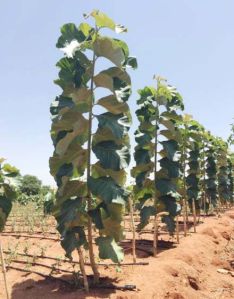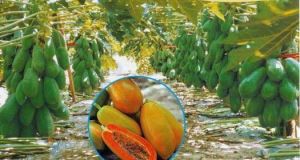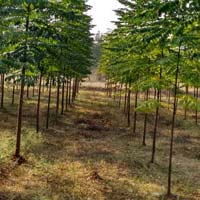
Teak Plant
Known as king of timber belongs to the family Verbenaceae. Its scie ntific name is Tectona grandis. It grows as a huge tree and yields excellent quality wood. Therefore teak wood has higher demand in national as well as International markets. Articles made of teak wood have high durability/quality and hence with the increased consumption of teak in household and office interiors, teak has become an indispensable part of people's lives all over the world. if genetically superior teak plants are grown on commercial scale, it is possible to earn good profits with low risk. When grown on fertile soils with irrigation and scientific management, each tree yields 10 to15 Cu. ft wood in about 14 years. The main stem grows to a height of 25-30 ft. and attains a girth of 35-45 inches. About 400 genetically superior teak plants can be grown in one acre. History of Teak wood : Teak wood is known as king of timber belongs to the family Verbenaceae. Its scientific name is Tectona grandis. It grows as a huge tree and yields excellent quality wood. Therefore teak wood has higher demand in national as well as International markets. Articles made of teak wood have high durability/quality and hence with the increased consumption of teak in household and office interiors, teak has become an indispensable part of people's lives all over the world. Uses : Teak has a high oil content making it very weather resistant, therefore it offers good elasticity. This means it's an ideal timber for garden furniture and boat decks, amongst other things. Another great benefit of Teak's high oil content is that it gives the wood a high resistance against insect infestation. It is a hard and heavy wood, with older teak trees supplying the best quality timber. However, Teak has high silica content; making it renowned for blunting wood working tools.
...more
Sandalwood Plants
World�s most popular and costliest wood is sandal wood. Sandal is widely known as Chandanamu, Srigandhamu in south India and Chandan in North. It is one of the renowned trees from ancient days. Hindus use this wood and its paste for pooja and religious use. Sandal wood is a small evergreen tree, and partial root parasite, attaining a height of 12-15 meters & girth of 100 to 200 cms with slender drooping as well as erect branching. The tree starts flowering at an early age of 2 to 3 years, Fruit is drupe, purplish, when fully mature and single seeded. Sandal wood is also considered as medicinal plant & is used on large scale in the manufacture of Ayurvadic Medicines. National Medicinal Plant Board, Govt.of India had recognized has a medicinal plant. Botanical Name: Santalum album Inn. Family: Santalaceae Regional Names: English : Sandal tree, White sandal tree. Hindi :Safed Chandan, Santal. Telugu :Chandanamu, Gandhapuchekka, Sri Gandhamu SANDAL YIELD: Sandal tree yields two kinds of wood sapwood and heart wood and yield from inter crops. Parts Used: Heart Wood and Sap Wood. The heart wood is a yellowish brown or orange color.Sap wood is lighter in color and used in ornamental items and furniture, carved boxes, jewel cases, combs, hand fans and walking sticks etc. Medicinal Uses: The wood is bitter, dry, antipyretic, aphrodisiac useful in diseases of the heart, burning sensation, cold, bronchitis, vaginal discharges and small pox. The wood is tonic to the heart and the brain. Paste is useful in inflammation and head ache. It has antiseptic properties and can be applied to skin. Other Uses: The wood is largely used for making small domestic items; it retains its pleasant perfume for a long time. The wood powder is used for making Agarbathis and as incense powder. The oil is largely used as perfume in in toilet fresheners� preparations and in insecticides also.
...more
Red Sandal
Red sandalwood is only found in the South, in India. This wood has been traditionally used as a sacred wood in religious functions and during pujas, havans[homas] purpose. Red Chandan is also used in ayurvedic medicine. In a Red sandalwood tree, the wood at the center of the trunk (heartwood) is mainly used for medical purposes. Botanical Name: Pterocarpus santalinuss. Family: Pterocarpus Hindi :Lal Chandan Telugu : Raktachnadanam Benifits: Red Sandalwood's natural dye, Santalin, is used as colorant in food, alcoholic beverages, add color, nutrrient value to processed food beverages,impart red color to alcoholic beverages, wood polish, metal vanish, textiles, wool, silk, leather, jute, dye for skin (Sun-tan), hair dye, medicinesm tablet coating colorant, and as dye for dye sensitized solar cells. It is also an effective color additive to body powders and scrubs. Uses It is used in herbal medicine, ayurvedic medicines, Viagra tablet, drug manufacturing, cosmetics, most valuable furniture and musical instruments. Other Uses Red sandalwood might increase the loss of body water through the urine (diuretic effect). It might also have drying effects that may help reduce diarrhea and break up mucus to make it easier to cough up. It is an antiseptic, wound healing agent. Red sandalwood has many uses for your hair, feet, skin and a variety of ailments. It helps promote a clean and clear skin tone, and maintain a good complexion. Make a paste to treat your pimples using red sandalwood powder, turmeric and water. As a night time treatment, apply the paste on to your pimples. Add a small piece of camphor to the formula for a cooling affect. Your pimples should fade away within a few hours. Combining coconut oil, almond oil and sandalwood powder makes a great toner. Apply the combination to all of the exposed parts on your face. The toner will keep your skin tone balanced. This combination can also remove an unwanted suntan.
...more
Papaya Plant
Category: Fruit Plants Family: Caricaceae Light: Sun growing Water: Normal Primarily grown for: Fruit or Seed Flowering season: Year-around flowering, Flowers in flushes throughout the year Flower or Inflorescence color: Cream, Off white, Light Yellow Foliage color: Green Plant Height or length: 4 to 6 meters Plant Spread or Width: 2 to 4 meters Plant Form: Upright or Erect Special Character: Fragrant flowers or leaves Attracts birds Attracts butterflies Attracts bees Quick growing trees Evergreen trees Salt or salinity tolerant Good on seaside Must have for Farm house or big gardens Growing tips: Climate - Papaya grows well in warm (but not hot) climates. It generally grows well up to 700 meters above sea level. Tolerates temprature of up to 38- 44 deg celcius. Soil - All kind of soils are suitable. Well drained fertile soils with good organic matter content are best. However Papaya grows well in most soils having good drainage. Soil ph of 6 to 7 is fine. Planting distance - Plants can yield for over a 5 years. For small to medium varieties the planting should be done at 1.8 x 1.8 meter. For tall variety the planting should be done at 2.4 x 2.4 meter. Planting - Planting is recommended in all year around. Pits of 0.5 meter width x 0.5 meter length x 0.5 meter deep should be taken. Top soil from these pits should be mixed 10 kgs farm yard manure well decomposed cow dung manure. 1 kgs single super phosphate and 100 gm follidol dust. Mix evenly to ensure proper distribution of the manure, fertilizer and pesticide. Watering - Watering can be done every 10 to 15 days in winter and at weekly intervals during summer. Drip irrigation is recommended. Manures and fertilizer - AGE OF PLANT MANURE 15:15:15 1 month 2 kg 335 gm 3 month 2 kg 335 gm 5 month 2 kg 335 gm 7 month 2 kg 335 gm Insect pests: Aphids, Spider Mites
...more
malabar neem plant
Malabar Neem originates from the Meliaceae family and is an indigenous species of tree to India, South East Asia and Australia, where it has been cultivated as a source of firewood. The tree can be cultivated in all types of soil and requiring a low supply of water . Malabar Neem has the unique feature of growing to 40 feet within 2 years from planting and can be mechanically pruned and harvested. Malabar Neem is a specie belonging to the Neem family. This tree is known for its fast growth. In recent times the farmers around Karnataka, Tamil Nadu, Andhra Pradesh & Kerala have found the utility of this tree both as a low grade timber and also a very useful wood for ply wood industry. Under irrigated conditions this tree can be harvested at the end of 5th year for both timber and ply wood purpose. Botanical Name: Melia Dubia. Family: Meliaceae Telugu :Malabaru Vepa Uses : The wood is used for packing cases, cigar boxes, ceiling planks, building purposes, agricultural implements, pencils, match boxes, splints and Kattamarams. In Ceylon, it is employed for outriggers of boats. It is suitable for musical instruments, tea boxes and plyboard. It is a good fuel wood. Characteristics : The sapwood is greyish white; heartwood light pink to light red turning pale russet brown on ageing. It is lustrous with dry feel, very light (spl gr- 0.33; wt � 21 Ib. /cu ft.) straight grained and coarse and somewhat uneven � textured. The timber is not durable in exposed positions but moderately so under cover. It is not so strong and durable as neem. It seasons well if logs are converted in a green state. If left long, the log is liable to develop end � splitting and discolouration. The best method of dealing with the timber is to convert the logs immediately after felling and to open � stack sawn material, preferably under cover, to avoid grey stain.
...more
Red Sandal Wood Plant

malabar neem
Be first to Rate
Rate This